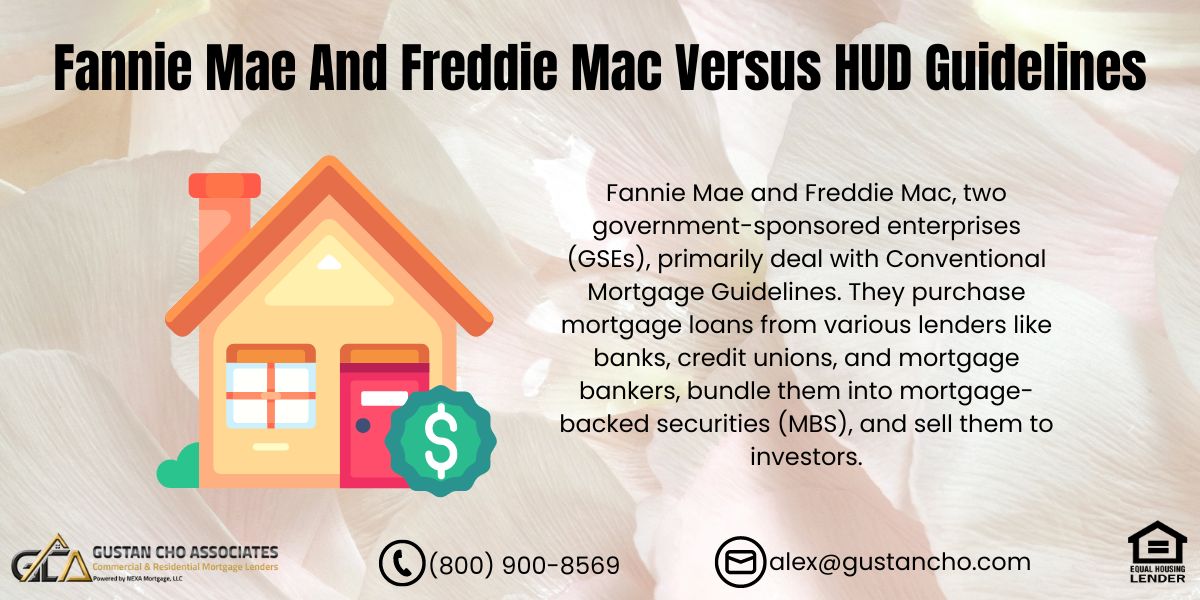This article explores the differences between Fannie Mae And Freddie Mac Versus HUD Guidelines. Acknowledging the complexity of the mortgage business, even for professionals, reflects on the comprehensive overhaul following the 2008 Real Estate and Financial Collapse.
This period saw the emergence of new government-sponsored agencies, accompanied by the implementation of Dodd-Frank legislation, the launch of the SAFE ACT, and the establishment of the CFPB. Amidst these changes, Fannie Mae and Freddie Mac experienced significant transformations.
Mortgage Agencies And Their Roles
Here are the various agencies and what type of loan program they are in charge of regulating and setting up mortgage guidelines:
- Fannie Mae and Freddie Mac are two mortgage giants in the United States that are in charge of setting up Conventional Mortgage Guidelines
- The typical mortgage consumers do not come in direct contact with the role Fannie Mae and Freddie Mac
- The Role Of Fannie Mae and Freddie Mac work with lenders and not with individual mortgage loan borrowers
- HUD, the United States Department of Housing and Urban Development, is in charge of FHA
- The Federal Housing Administration is a subsidiary of HUD
- HUD, like Fannie Mae and Freddie Mac, is in charge of setting up mortgage guidelines for FHA Loans
- Fannie Mae and Freddie Mac is in charge of Conventional Mortgage Guidelines
Fannie Mae and Freddie Mac are two mortgage giants that play an important role in our mortgage lending industry and our economy.
What is the Difference Between HUD and Fannie Mae?
HUD, or the U.S. Department of Housing and Urban Development, is a federal agency tasked with addressing housing needs, enhancing communities, and enforcing fair housing laws. Programs offered include public housing, Section 8 rental assistance, and homeowner initiatives to provide affordable housing options. Managing disaster recovery efforts related to housing and community development heavily relies on HUD.
On the other hand, Fannie Mae, formally known as the Federal National Mortgage Association, operates as a government-sponsored enterprise in the secondary mortgage market. Unlike HUD, Fannie Mae doesn’t directly originate or service mortgages. Instead, it purchases mortgage loans from lenders, combines them into pools, and sells them as mortgage-backed securities to investors.
This process injects liquidity into the mortgage market, enabling lenders to continue extending loans to prospective homebuyers. Moreover, Fannie Mae establishes underwriting standards for the loans it acquires, influencing lending criteria in the primary mortgage market. Speak With Our Loan Officer About Fannie Mae
Is Freddie Mac the Same as HUD?
Freddie Mac is another government-sponsored enterprise (GSE) similar to Fannie Mae, operating in the secondary mortgage market.
Like Fannie Mae, Freddie Mac does not directly originate mortgages but purchases them from lenders, packages them into mortgage-backed securities (MBS), and sells them to investors. This activity helps to provide liquidity to the mortgage market, ensuring that lenders have the funds to continue making new loans to homebuyers.
Are Fannie Mae and Freddie Mac Guidelines the Same?
The secondary mortgage market is governed by Fannie Mae and Freddie Mac, which have comparable objectives and guidelines, but there may be minor discrepancies due to several factors. However, both entities generally align their standards to maintain consistency and stability.
They operate under the oversight of the Federal Housing Finance Agency (FHFA), which ensures their activities serve the best interests of the housing finance system. Overall, while there may be variations in specific guidelines, their overarching objectives and requirements tend to be similar and aimed at ensuring high-quality loans.
Fannie Mae And Freddie Mac Versus HUD And Function
Basic Role Of Fannie Mae And Freddie Mac Versus HUD
The role of Fannie Mae and Freddie Mac is to purchase mortgage loans originated by the following:
- Banks
- Credit unions
- Mortgage bankers
- Credit unions
Mortgage bankers need to sell the loans they originated to relieve their inventory and lines of credit in order to generate more mortgage loans. The Role Of Fannie Mae and Freddie Mac, together, are responsible for securing close to $6.0 trillion in mortgage loans which make up almost 50% of this country’s total mortgage loans.
Difference Between Fannie Mae And Freddie Mac
Both the role of Fannie Mae and Freddie Mac’s purpose is to purchase and guarantee mortgage loans. Fannie Mae was formed and created under the watch of Franklin D. Roosevelt back in 1938. The purpose was to insure that mortgage funding was sufficient and available at all times. Especially during periods of depression and tougher economic times.
Fannie Mae became a public enterprise back in 1968 and was publicly traded. Freddie Mac was formed back in 1970. The reason Freddie Mac was created was to create competition with Fannie Mae. The purpose was so that Fannie Mae would not have a monopoly on mortgage loans. Mortgage loans that both Fannie Mae and Freddie Mac purchased were all bundled up to form mortgage-backed securities, also known as MBS.
2008 Real Estate Meltdown And Fannie Mae And Freddie Mac

Both Fannie Mae and Freddie Mac came into financial crisis due to the real estate and credit market collapse. As housing values tanked, many mortgage loan borrowers defaulted on their mortgage loans. Institutional investors backed out of investing in mortgage-backed securities.
Both these institutions were nearly bankrupt and the government had to step in to bail them out. Without the government stepping in, Fannie Mae and Freddie Mac would have gone bankrupt and the housing crisis would have been detrimental. The United States government, American taxpayers, are responsible for guaranteeing all mortgage loans issued by both Fannie Mae and Freddie Mac.
Bottom line is that if mortgage loans held by Fannie Mae and Freddie Mac defaults, the American taxpayers are ultimately responsible. Click here to qualify for a mortgage with low credit scores
Objectives Of Fannie Mae And Freddie Mac Versus HUD
Fannie Mae and Freddie Mac’s objectives are to purchase mortgage back securities, relieve mortgage lenders’ inventory of mortgage loans. This was so they can reuse their warehouse lines of credit to originate more mortgage loans, stimulate homeownership, attract investors, but yet, minimize defaults on mortgage loans.
The real estate and credit market crash of 2008 skyrocketed foreclosure rates. Prior to the financial and real estate collapse, both Fannie Mae and Freddie Mac had lenient mortgage lending guidelines. Products such as stated income mortgage loan programs which resulted in them backing much riskier mortgage loans were very popular.
The result was recorded default rates in mortgage loans and historical high foreclosure rates and plummeting housing values.
Differences Of Fannie Mae Versus Freddie Mac
Here are the main differences between Fannie/Freddie and HUD:
- Fannie and Freddie buy Conventional Loans that conform to their Conventional Guidelines
- HUD does not purchase FHA Loans
HUD will only insure FHA Loans to lenders that meet FHA Guidelines in the event of borrower default.
Qualifying For Mortgage With Direct Lender With No Overlays
Home Buyers needing to qualify for government and/or conventional loans with no lender overlays can contact us at Gustan Cho Associates at 800-900-8569 or text us for a faster response. Or email us at alex@gustancho.com. Gustan Cho Associates is a mortgage company licensed in multiple states with no lender overlays on government and conventional loans and offer alternative financing programs.
The team at Gustan Cho Associates also offers non-traditional mortgage loan programs such as NON-QM Loans, Bank Statement Loans for self-employed borrowers, and two-time perm construction loans. We also offer escrow advances on refinancing mortgages. Qualify for mortgage with direct lender with no overlays
FAQ: Fannie Mae And Freddie Mac Versus HUD Guidelines
1. What are Fannie Mae and Freddie Mac responsible for? Fannie Mae and Freddie Mac, two government-sponsored enterprises (GSEs), primarily deal with Conventional Mortgage Guidelines. They purchase mortgage loans from various lenders like banks, credit unions, and mortgage bankers, bundle them into mortgage-backed securities (MBS), and sell them to investors. This process provides liquidity to the mortgage market, enabling lenders to issue more loans.
2. How does HUD differ from Fannie Mae and Freddie Mac? HUD (U.S. Department of Housing and Urban Development) oversees FHA (Federal Housing Administration) loans. Unlike Fannie Mae and Freddie Mac, which operate in the secondary mortgage market, HUD directly manages public housing, Section 8 rental assistance, and FHA loan programs. While Fannie Mae and Freddie Mac focus on conventional loans, HUD deals with government-insured FHA loans.
3. Are the guidelines of Fannie Mae and Freddie Mac the same? While Fannie Mae and Freddie Mac have similar objectives and guidelines, there may be minor differences due to various factors. However, both entities generally align their standards to maintain consistency and stability in the secondary mortgage market. The Federal Housing Finance Agency (FHFA) oversees both GSEs to ensure their activities serve the best interests of the housing finance system.
4. What is the role of Fannie Mae and Freddie Mac compared to HUD? Fannie Mae and Freddie Mac aim to ensure liquidity in the mortgage market through the purchase and guarantee of mortgage loans. In contrast, HUD administers FHA loan programs and manages various initiatives to address housing needs directly and enhance communities. Fannie Mae and Freddie Mac operate as government-sponsored enterprises, while HUD is a federal agency.
5. What were the impacts of the 2008 Real Estate and Financial Collapse on Fannie Mae and Freddie Mac? The 2008 collapse significantly affected Fannie Mae and Freddie Mac, leading to a financial crisis due to mortgage loan defaults and a housing market downturn. The government intervened to prevent their bankruptcy, highlighting these entities’ crucial role in the housing finance system. Ultimately, taxpayers guarantee mortgage loans issued by Fannie Mae and Freddie Mac.
6. How can I qualify for a mortgage with no lender overlays? Homebuyers seeking to qualify for government or conventional loans without lender overlays can contact Gustan Cho Associates, a mortgage company licensed in multiple states. They offer alternative financing programs and specialize in providing mortgages with no lender overlays. Additionally, they offer non-traditional mortgage loan programs tailored to various borrower needs.
This blog about the Fannie Mae And Freddie Mac Versus HUD Guidelines was updated on April 1st, 2024.







